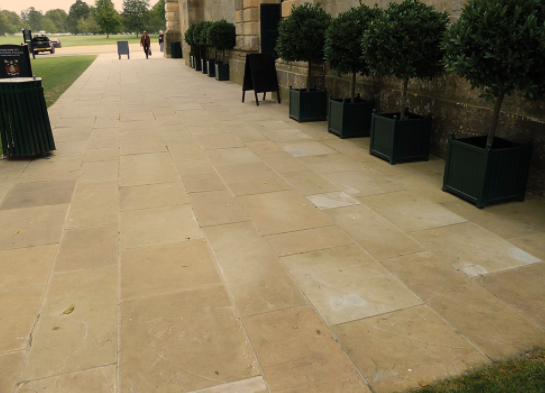Types of yorkstone
The sandstone blocks used for making yorkstone products are separated into two categories. One has highly visible sedimentary layers and is used for riven paving and other riven yorkstone products. The term ‘riven’ comes from riving (splitting) the block apart. This block is referred to as flagrock or flagblock.
Yorkstone also referred to as Yorkshire natural stone is a native sandstone which is appreciated widely for its excellent quality, toughness and robustness. Sandstone is actually known to be made over 300 million years ago and contains clay, quartz, mica, feldspar, silica and iron oxides.
Traditional skills at the quarry.
The quarrymen who ‘work’ the yorkstone are known as Delvers. Delph, Delf or Delvers comes from the Anglo Saxon word ‘delfan’ which means to dig. The early yorkstone quarries were smaller than those today and were called delphs. Some areas, street names and buildings in Yorkshire still have the name delph or delver. The ‘Delvers Arms’ public house, ‘Delvers Cottage’ and ‘Delph Hill’ are just a few examples.
Yorkstone colours
The colour of yorkstone depends on the minerals within its makeup and differs from quarry to quarry Quarried blocks are rusty red to brown in colour on the outside and are usually a sandy yellow colour on the inside. This sandy colour can clearly be seen on the inside of the blocks when they are sawn into yorkstone slabs or riven into yorkstone paving. Orange bands known as concretion lines can also be seen on the inside of the blocks when exposed with sawing or riving.
YORKSTONE IS VERSATILE AND RESILIENT
Yorkstone comes in a selection of shades depending on the minerals throughout the stone and where it is quarried from. Ordinarily the shades on the exterior is red to brown while on the interior it is a sandy yellow colour. We have a tendency to notice the yellow colour in the paving stones as the stone has been trimmed and laid right into place.
It really has ended up being a prominent stone to make use of in these kinds of high streets as it was remarkably tough and also together with mortar packed by the side of it, it appeared to be an even surface area helping to make certain there was a toned down danger of incidents with horses and wagons passing through the high street throughout the day. This particular preferred choice of stone might probably likewise prove weather resistant and would likely at no time create any kind of pot holes.
Yorkstone can become slippery when it is dirty and algae can also form on top of it so a monthly clean may be required. Anyone can certainly keep on top of the algae with a weak bleach mix with water. If the stone is highly blemished then a patio cleaning agent will be more well-suited which you can hire one from a gardening centre or hire a service to keep on top of it.
At present this first class stone is furthermore used in building and construction sector for usage of house signs, footpaths, driveways, walls, patios, steps, garden ornaments, garden memorials and far more. Many individuals like its functionality along with its own attractive style.
In the present day the majority of highways have indeed been removed and replace with tarmac to assist reduce the roadways with big cars which includes vans but we continue to work with the Yorkstone cobble sidewalks in cosmetic utilisation just like garden features along with driveway cobbles.
A different early applicability in regard to Yorkstone would definitely be to come up with stone walls all around Holy places, residencies along with parishes. Yorkstone was really highly sought-after as it ended up to be trustworthy and quickly developing metropolitan areas and even neighborhoods would undoubtedly put into action Yorkstone to create their neck of the woods.
Stone for rockeries
Other layers in the yorkstone quarry include cross-bedded sandstone that can not be used for paving or sawing due to its shape These are often loose layers and are used for making rockery garden pieces and dry stone walling. Another layer is made up of hard shale blocks called rag blocks which are also used for garden rockeries and water features. Clay, mudstone, siltstone and soft shale make up the rest of the layers in a yorkstone quarry.
Yorkstone: versatile and durable
The stone was used in Yorkshire for walling, and the traditional local skill of building dry stone walls using yorkstone continues to this day. Another early use was for roofing, made from split stones known locally as thackstone or grey slate. Yorkstone’s fame really took off with the need to lay concrete the rapidly expanding towns and cities of the industrial revolution. Its versatility and durability led to its use in a huge range of building projects from footpaths, roads and dry stone walling to churches, cathedrals, bridges, houses and intricately carved monuments.
GOOD OLD DAYS
Best understood for its own usage as paving stones and also house signs in old fashioned high streets throughout United Kingdom. Lots of folks will recognize London as having standard paving stones used directly from Yorkstone.
The second kind of block is more compressed, and the sedimentary layers are not as visible and can not be riven apart. This type of block is referred to as ashlar block and is used for sawn yorkstone products such as sawn paving and sawn slabs for masonry work and for garden statues and sculptures.
Yorkstone has been taken out from West Yorkshire quarries ever since medieval times. This particular method ended up being much more continual and at the 18th century it had turned into a sizeable flagstone commercial enterprise.
That stone does not call for a lot of upkeep to which in turn is just one of the main reasons lots of people make a decision on this stone. This particular stone does not need cleaning to keep its resilience in place, tidying up the stone is usually an aesthetic detail.





